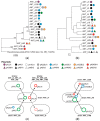Diversity and Horizontal Transfer of Antarctic Pseudomonas spp. Plasmids
- PMID: 31661808
- PMCID: PMC6896180
- DOI: 10.3390/genes10110850
Diversity and Horizontal Transfer of Antarctic Pseudomonas spp. Plasmids
Abstract
Pseudomonas spp. are widely distributed in various environments around the world. They are also common in the Antarctic regions. To date, almost 200 plasmids of Pseudomonas spp. have been sequenced, but only 12 of them were isolated from psychrotolerant strains. In this study, 15 novel plasmids of cold-active Pseudomonas spp. originating from the King George Island (Antarctica) were characterized using a combined, structural and functional approach, including thorough genomic analyses, functional analyses of selected genetic modules, and identification of active transposable elements localized within the plasmids and comparative genomics. The analyses performed in this study increased the understanding of the horizontal transfer of plasmids found within Pseudomonas populations inhabiting Antarctic soils. It was shown that the majority of the studied plasmids are narrow-host-range replicons, whose transfer across taxonomic boundaries may be limited. Moreover, structural and functional analyses enabled identification and characterization of various accessory genetic modules, including genes encoding major pilin protein (PilA), that enhance biofilm formation, as well as active transposable elements. Furthermore, comparative genomic analyses revealed that the studied plasmids of Antarctic Pseudomonas spp. are unique, as they are highly dissimilar to the other known plasmids of Pseudomonas spp.
Keywords: Antarctica; Pseudomonas; biofilm; horizontal gene transfer; plasmid; transposable element.
Conflict of interest statement
The authors declare no conflict of interest.
Figures





Similar articles
-
Molecular characterization of the pA3J1 plasmid from the psychrotolerant Antarctic bacterium Pseudomonas sp. ANT_J3.Plasmid. 2017 Jul;92:49-56. doi: 10.1016/j.plasmid.2017.08.001. Epub 2017 Aug 9. Plasmid. 2017. PMID: 28802584
-
Insight Into the Diversity and Possible Role of Plasmids in the Adaptation of Psychrotolerant and Metalotolerant Arthrobacter spp. to Extreme Antarctic Environments.Front Microbiol. 2018 Dec 18;9:3144. doi: 10.3389/fmicb.2018.03144. eCollection 2018. Front Microbiol. 2018. PMID: 30619210 Free PMC article.
-
Pseudomonas, the dominant polycyclic aromatic hydrocarbon-degrading bacteria isolated from Antarctic soils and the role of large plasmids in horizontal gene transfer.Environ Microbiol. 2006 Mar;8(3):455-65. doi: 10.1111/j.1462-2920.2005.00911.x. Environ Microbiol. 2006. PMID: 16478452
-
The interconnection between biofilm formation and horizontal gene transfer.FEMS Immunol Med Microbiol. 2012 Jul;65(2):183-95. doi: 10.1111/j.1574-695X.2012.00960.x. Epub 2012 Apr 23. FEMS Immunol Med Microbiol. 2012. PMID: 22444301 Review.
-
Genomics of IncP-1 antibiotic resistance plasmids isolated from wastewater treatment plants provides evidence for a widely accessible drug resistance gene pool.FEMS Microbiol Rev. 2007 Jul;31(4):449-77. doi: 10.1111/j.1574-6976.2007.00074.x. Epub 2007 Jun 6. FEMS Microbiol Rev. 2007. PMID: 17553065 Review.
Cited by
-
Plasmid Backbone Impacts Conjugation Rate, Transconjugant Fitness, and Community Assembly of Genetically Bioaugmented Soil Microbes for PAH Bioremediation.ACS Environ Au. 2025 Jan 22;5(2):241-252. doi: 10.1021/acsenvironau.4c00123. eCollection 2025 Mar 19. ACS Environ Au. 2025. PMID: 40125281 Free PMC article.
-
Ecological Interaction between Bacteriophages and Bacteria in Sub-Arctic Kongsfjorden Bay, Svalbard, Norway.Microorganisms. 2024 Jan 28;12(2):276. doi: 10.3390/microorganisms12020276. Microorganisms. 2024. PMID: 38399681 Free PMC article.
-
Molecular Characterization and Comparative Genomics of IncQ-3 Plasmids Conferring Resistance to Various Antibiotics Isolated from a Wastewater Treatment Plant in Warsaw (Poland).Antibiotics (Basel). 2020 Sep 17;9(9):613. doi: 10.3390/antibiotics9090613. Antibiotics (Basel). 2020. PMID: 32957637 Free PMC article.
-
A Pseudomonas Lysogenic Bacteriophage Crossing the Antarctic and Arctic, Representing a New Genus of Autographiviridae.Int J Mol Sci. 2023 Apr 21;24(8):7662. doi: 10.3390/ijms24087662. Int J Mol Sci. 2023. PMID: 37108829 Free PMC article.
References
-
- Pinjari A.B., Pandey J.P., Kamireddy S., Siddavattam D. Expression and subcellular localization of organophosphate hydrolase in acephate-degrading Pseudomonas sp. strain Ind01 and its use as a potential biocatalyst for elimination of organophosphate insecticides. Lett. Appl. Microbiol. 2013;57:63–68. doi: 10.1111/lam.12080. - DOI - PubMed
Publication types
MeSH terms
Substances
LinkOut - more resources
Full Text Sources
Molecular Biology Databases
Miscellaneous

